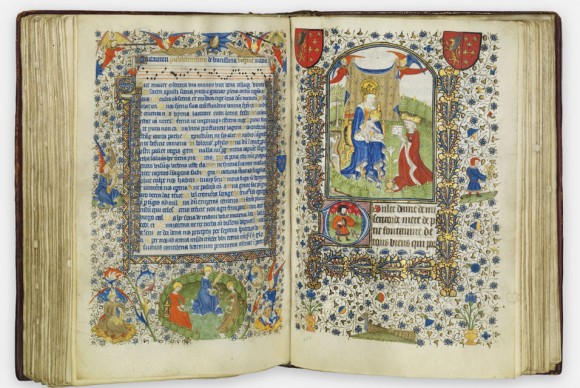Christie’s to Offer Valuable Collection of Illuminated Manuscripts
March 25, 2010 by All Art News
Filed under Antiques & Archaeology
LONDON.- Christie’s announce that they will offer the first part of an extensive selection of exceptional medieval and renaissance masterpieces on 7 July 2010 in London. The Arcana Collection: Exceptional Illuminated Manuscripts and Incunabula Part I is an outstanding private collection which has been assembled over the past 3 decades and which includes personal prayer books made for Royals, Bishops, Aristocracy and other important patrons from the 13th century to the 16th century. These include King François I of France, a leading patron of Leonardo da Vinci and the first owner of his masterpiece The Mona Lisa, as well as King Henry IV of France and Elizabeth de Bohun, great grandmother of King Henry V of England.
The collection will offer 48 lots with an overall estimate of £11 million to £16 million, and will be on public exhibition for the first time, alongside Christie’s July auction of Old Masters and 19th Century Art from 3 to 7 July 2010.

The Cauchon Hours was made in the middle of the 15th century for a noble couple from Rheims, who are portrayed as a knight in armour and his elegantly robed lady. The miniatures are accompanied by enchanting vignettes, both reflections of their daily surroundings and engaging inventions. All are represented with delicacy and verve in a light bright palette to make the manuscript a masterpiece of medieval charm. Estimate: £800,000 to £1,200,000. Photo: Christie's Images Ltd., 2010
Some of the most highly priced items in the inventories of renaissance kings and princes were illuminated manuscripts – handwritten books with illustrations and decorations painted in brilliant colours and gold. It was not simply the cost of materials and labour – their visual richness makes each book the equivalent of a gallery of paintings – but it is their aesthetic quality that led to these books being so highly valued, for the artists who painted them were often the leading artists of their day. Such books were among the most eloquent demonstrations of the wealth and refined taste of their owners.
Books of Hours, prayerbooks intended for private use, were the most popular type of illuminated manuscript and they are splendidly represented in the Arcana collection. Because the Book of Hours were designed for personal use, their content and appearance could be tailored to an individual’s preference, reflecting his or her concerns, interests and taste. Their purpose was not solely religious – the finest were clearly meant to visually delight both the owner and everyone to whom they were shown: they were meant for display and as demonstrations of status and discernment. Owners were often identified and represented in these books, their portraits showing them richly dressed in the height of contemporary fashion.
Highlights of the collection include:
• A Book of Hours opulently illuminated for King François I of France by the Master of François de Rohan is expected to realise £300,000 to £500,000. François I, celebrated as one of the greatest princely patrons of the Renaissance, commissioned art and architecture of the highest quality attracting to his court the leading artists of his day. Leonardo da Vinci was eminent among them and spent his final years in the king’s employ. After Leonardo’s death François I acquired what is probably the world’s most famous painting, The Mona Lisa, from the artist’s estate.
• Executed in England in the 14th century, the Hours and Psalter of Elizabeth de Bohun, Countess of Northampton and great-grandmother of King Henry V of England, are expected to realise £2,000,000 to £3,000,000. These were lent by a previous owner, William Waldorf Astor, to the important loan exhibition in New York 1883 that raised funds for a pedestal for The Statue of Liberty.
• A manuscript Bible produced in Italy in the middle of the 13th century with extensive and exquisite painted illustration. It appears to have been made for the use of a convent of Dominican friars – but the borders include diverting genre scenes and fantastical creations far from the routine religious illustrations that might be expected. The death of Theodoric Borgognoni (c.1296) is recorded in the Calendar and he may have commissioned the work: not only a Dominican friar and Bishop of Cervia he was one of the most significant and innovative surgeons of the medieval period. This Bible carries an estimate of £2,500,000 to £3,500,000.
• The sumptuous Epistres d’Ovide, the earliest translation into French Ovid’s Heroines, was made for Anne of Brittany, Queen to two Kings of France, Charles VIII and Louis XII, and mother of the wife of a third – Francois I. (estimate: £500,000 to £800,000)
• The first edition of Boccaccio’s On Famous Women (estimate: £250,000 to £350,000) was printed at Ulm in 1473, and is also a masterpiece of German woodcut illustration. This copy was formerly owned by W.E. Gladstone, Hawarden Castle.
• The first edition of Pliny’s Natural History in Italian (estimate: £250,000 to £350,000) is a masterpiece of early typography, printed at Venice by Nicolas Jenson in 1476, and exquisitely illuminated for the Bolzani family by the Master of the Seven Virtues.
• The Cauchon Hours was made in the middle of the 15th century for a noble couple from Rheims, who are portrayed as a knight in armour and his elegantly robed lady. The miniatures are accompanied by enchanting vignettes, both reflections of their daily surroundings and engaging inventions. All are represented with delicacy and verve in a light bright palette to make the manuscript a masterpiece of medieval charm (estimate: £800,000 to £1,200,000).
• One of the most celebrated books of the Italian Renaissance: the Hypnerotomachia Poliphili (£220,000 to £260,000) to be offered at Christie’s in July is the copy originally owned by the most famous bibliophile of all time, Jean Grolier, and subsequently by Earl Spencer.
